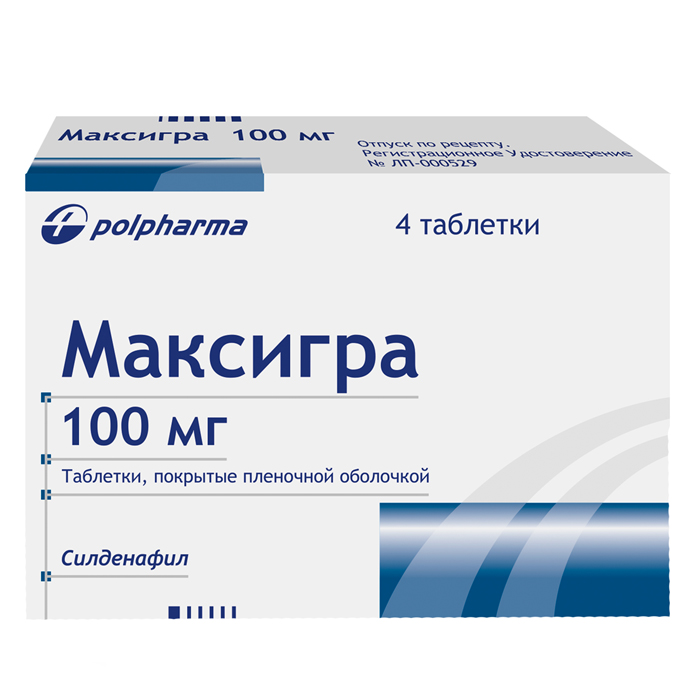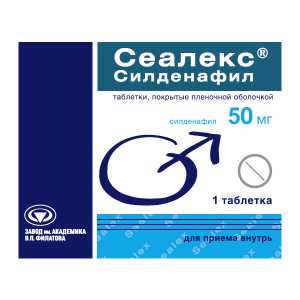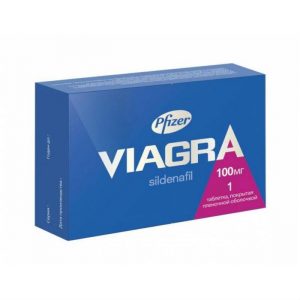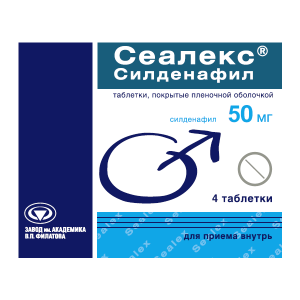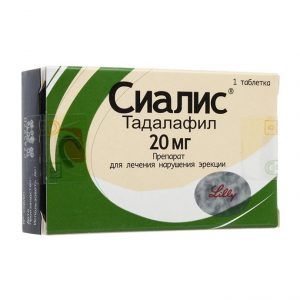Description
Release form
Tablets.
Packing
In the package 4 pcs.
Pharmacological action
Pharmacotherapeutic group: erectile dysfunction The treatment agent is PDE5 inhibitor.
ATX code: [G04BE03].
Pharmacological properties of
Pharmacodynamics
Sildenafil – a drug for the treatment of erectile dysfunction. With sexual stimulation, restores impaired erectile function by increasing blood flow to the penis.
Sildenafil is a potent and selective inhibitor of type 5 cGMP-specific phosphodiesterase (PDE5). Sildenafil does not have a direct relaxing effect on an isolated cavernous body, but it actively enhances the relaxing effect of nitric oxide (NO) on this tissue due to the inhibition of PDE5, which is responsible for the breakdown of cGMP in the cavernous body. When the NO / cGMP pathway is activated, inhibition of PDE5 under the influence of sildenafil leads to an increase in the level of cGMP in the cavernous body, resulting in muscle relaxation and increased blood flow in the cavernous body. The pharmacological effect is achieved only in the presence of sexual stimulation.
Activity in relation to PDE5 is 10-10000 times higher than activity in relation to other PDE isoenzymes (1-11).
In clinical studies, it was shown that the average time to achieve an erection resistance of 60% (sufficient to have sexual intercourse) was 25 minutes (range from 12 to 37 minutes).
In some patients, 1 hour after taking the drug at a dose of 100 mg using the Farnsworth-Munsell 100 test, a mild and transient impairment of the ability to distinguish colors (blue / green) was detected, 2 hours after taking the drug, these changes were absent. Inhibition of PDE6, which is involved in the process of light transmission in the retina, is considered a mechanism of color vision disturbance. Sildenafil does not affect visual acuity, contrast perception, electroretinogram, intraocular pressure or pupil diameter.
In healthy volunteers, after a single dose of 100 mg sildenafil, no effect on sperm motility or morphology was noted.
Pharmacokinetics
Absorption
After oral administration, sildenafil is rapidly absorbed. Absolute bioavailability averages 41% (range 25 63%). The maximum concentration (Cmax) in plasma with a single fasting 100 mg of the drug inside is 18 ng / ml (38 nM) and is achieved within 30-120 minutes (average 60 minutes).
When taking sildenafil along with fatty foods, Cmax decreases by 20-40% and is reached after 1.5-3 hours.
Distribution
The volume of distribution (Vd) of sildenafil in equilibrium is on average 105 l. Sildenafil and its main circulating N-desmethyl metabolite bind to plasma proteins by approximately 96%. Protein binding does not affect the overall concentration of the drug.
In healthy volunteers receiving sildenafil (a single dose of 100 mg), less than 0.0002% (average 188 ng) of the administered dose was determined in semen 90 minutes after administration.
Metabolism
Sildenafil is metabolized predominantly by the microsomal isoenzymes of the liver CYP3A4 (main pathway) and CYP2C9 (secondary pathway). The main circulating metabolite is formed from sildenafil by N-demethylation. This metabolite has a phosphodiesterase selectivity profile similar to that of sildenafil, and its activity against PDE5 in vitro is approximately 50% of the activity of the parent drug. The concentration of this metabolite in plasma is approximately 40% of the concentration of sildenafil. Subsequently, the metabolite N-desmethyl is metabolized, while its half-life (T ) Is about 4 hours.
Excretion
The total clearance of sildenafil is 41 l / h, and T in the terminal phase – 3-5 hours After oral administration, sildenafil is excreted in the form of metabolites mainly by the intestines (approximately 80% of the dose) and to a lesser extent by the kidneys (approximately 13% of the dose).
Pharmacokinetics in special clinical cases
Elderly patients
In elderly (over 65) patients, the clearance of sildenafil is reduced, and the concentration of free active substance in plasma is approximately 40% higher than that in young (18-45 years) patients.
Patients with renal failure
In case of renal failure, mild (KK 50-80 ml / min) and moderate (KK 30-49 ml / min) severity, the pharmacokinetic parameters of sildenafil are not changed once after oral administration (50 mg).
With severe renal failure (CC> 30 ml / min), the clearance of sildenafil is reduced, which leads to an approximately twofold increase in AUC (100%) and Cmax (88%) compared with those for normal renal function in patients of the same age group.
Patients with liver failure
In patients with mild to moderate liver cirrhosis (Child-Pugh class A and B), sildenafil clearance decreases, which leads to an increase in AUC (84%) and Cmax (47%) compared with those with normal liver function in patients of the same age group.
The pharmacokinetic parameters of sildenafil in patients with severe hepatic impairment have not been studied.
Contraindications
Hypersensitivity to sildenafil or to any other component of the drug.
Use in patients receiving continuously or intermittently nitric oxide donors, organic nitrates or nitrites in any form, since sildenafil enhances the hypotensive effect of nitrates (see section “Interaction with other drugs”).
The safety and effectiveness of sildenafil when used together with other treatments for erectile dysfunction have not been studied, so the use of such combinations is not recommended (see section “Special instructions”).
According to the registered indication, sildenafil is not intended for use in children under 18 years of age.
According to the registered indication, sildenafil is not intended for use in women.
With caution
Anatomical deformation of the penis (including during angulation, cavernous fibrosis, or Peyronie’s disease) (see section “Special instructions”).
Diseases predisposing to the development of priapism (sickle cell anemia, multiple myeloma, leukemia, thrombocytopenia) (see. Special Instructions).
Patients with a history of anterior ischemic optic neuropathy of an optic nerve of a non-inflammatory genesis.
Diseases accompanied by bleeding.
An exacerbation of peptic ulcer of the stomach and duodenum.
Hereditary retinitis pigmentosa (see Special Instructions)
Heart failure, unstable angina, myocardial infarction, stroke or life-threatening arrhythmias, arterial hypertension (BP> 170/100 mm Hg) or hypotension (over the past 6 months) HELL <90/50 mm Hg) (see section "Special Instructions"). Concomitant use of alpha-blockers. Use during pregnancy and lactation Sildenafil is not intended for use in women. Special instructions Before prescribing treatment, it is necessary to collect a medical history and conduct a physical examination to diagnose erectile dysfunction and determine the possible causes of its development. Treatments for erectile dysfunction should be used with caution in patients with anatomical deformation of the penis (angulation, cavernous fibrosis, Peyronie’s disease), or in patients with risk factors for priapism (sickle cell anemia, multiple myeloma, leukemia) (see section ² ÑPrecautions ² Ñ “). If an erection persists for more than 4 hours, seek medical attention immediately. If priapism therapy is not carried out in a timely manner, this can lead to damage to the tissues of the penis and irreversible loss of potency. Drugs intended for the treatment of erectile dysfunction should not be prescribed to men for whom sexual activity is undesirable. Since sexual activity poses a certain risk in the presence of heart disease, before starting any therapy for erectile dysfunction, the doctor should refer the patient to an examination of the patient’s cardiovascular system. Sexual activity is undesirable in patients with heart failure, unstable angina pectoris, myocardial infarction or stroke in the last 6 months, life-threatening arrhythmias, arterial hypertension (blood pressure> 170/100 mmHg) or hypotension (blood pressure <90/50 mmHg) Art.). Clinical studies have shown no differences in the incidence of myocardial infarction (1, 1 per 100 people per year) or the mortality rate from cardiovascular diseases (0.3 per 100 people per year) in patients receiving sildenafil, compared with patients receiving placebo. Cardiovascular complications During the post-marketing use of sildenafil for the treatment of erectile dysfunction, adverse events such as severe cardiovascular complications (including myocardial infarction, unstable angina pectoris, sudden cardiac death, ventricular arrhythmia, hemorrhage, were reported ischemic attack, hypertension and hypotension), which had a temporary relationship with the use of sildenafil. Most of these patients, but not all of them, had risk factors for cardiovascular complications. Many of these adverse events were observed shortly after sexual activity, and some were noted after taking sildenafil without subsequent sexual activity. It is not possible to establish the existence of a direct relationship between the observed adverse events and these or other factors. Hypotension Sildenafil has a systemic vasodilating effect, leading to a transient decrease in blood pressure, which is not a clinically significant phenomenon and does not lead to any consequences in most patients. Nevertheless, before prescribing sildenafil, the doctor should carefully assess the risk of possible unwanted manifestations of vasodilating action in patients with relevant diseases, especially against the background of sexual activity. Increased susceptibility to vasodilators is observed in patients with left ventricular outflow tract obstruction (e.g., aortic stenosis, hypertrophic obstructive cardiomyopathy), as well as a rare syndrome of multiple systemic atrophy, manifested by a severe violation of the regulation of blood pressure by the autonomic nervous system. Sildenafil should be prescribed with caution to patients taking alpha-blockers, since their combined use can lead to symptomatic hypotension in some sensitive patients. Most likely, this effect will develop within 4 hours after taking sildenafil. To minimize the risk of developing postural hypotension in patients taking alpha-blockers, treatment with sildenafil should be started after the hemodynamics in these patients have stabilized. The feasibility of lowering the initial dose of sildenafil should also be considered. The doctor should inform patients what actions should be taken in case of symptoms of postural hypotension. Visual disturbances of With the use of all PDE5 inhibitors, including sildenafil, rare cases of the development of anterior ischemic optic neuropathy of the optic nerve of non-inflammatory genesis have been noted as a cause of visual impairment or loss. Most of these patients had risk factors, such as a decrease in the ratio of the diameters of excavation and the optic disc ( ² Ñcongestive disc ² Ñ), over 50 years old, diabetes mellitus, arterial hypertension, coronary heart disease, hyperlipidemia, and smoking. In case of sudden visual impairment, the patient should be advised to stop taking sildenafil and consult a doctor immediately. A small number of patients with hereditary retinitis pigmentosa have genetically determined dysfunctions of the retinal phosphodiesterases. There is no information on the safety of sildenafil in patients with retinitis pigmentosa. Hearing impairment Some post-marketing and clinical studies report cases of sudden impairment or loss of hearing associated with all PDE5 inhibitors, including sildenafil. Most of these patients had risk factors for sudden impairment or hearing loss. A causal relationship between the use of PDE5 inhibitors and a sudden deterioration or loss of hearing has not been established. In case of sudden deterioration or loss of hearing while taking sildenafil, you should immediately consult your doctor. Bleeding Sildenafil enhances the antiplatelet effect of sodium nitroprusside, a nitric oxide donor, on human platelets in vitro. There is no safety data on the use of sildenafil in patients with a tendency to bleeding or exacerbation of peptic ulcer of the stomach and duodenum, therefore, sildenafil should be used with caution in these patients (see the “Caution” section). The frequency of nosebleeds in patients with PH associated with diffuse connective tissue diseases was higher (sildenafil 12.9%, placebo 0%) than in patients with primary pulmonary hypertension (sildenafil 3.0%, placebo 2.4%). In patients receiving sildenafil in combination with a vitamin K antagonist, the frequency of nosebleeds was higher (8.8%) than in patients who did not take a vitamin K antagonist (1.7%). Use with other treatments for erectile dysfunction The safety and effectiveness of the combined use of sildenafil with other PDE5 inhibitors, or other drugs for the treatment of pulmonary hypertension containing sildenafil, or other treatments for erectile dysfunction have not been studied, therefore, the use of such combinations is not recommended. Impact on the ability to drive vehicles and work with mechanisms. The effect of sildenafil on the ability to drive a car and perform work requiring increased attention has not been studied. However, during the period of taking the drug, care must be taken when driving vehicles and engaging in potentially hazardous activities that require an increased concentration of attention and speed of psychomotor reactions, as dizziness and visual impairment are possible. Composition of One tablet contains: active substance – sildenafil citrate 70.24 mg or 140.48 mg (equivalent to sildenafil) 50.00 mg or 100.00 mg, respectively, excipients: mannitol, crospovidone (crodpovidone ( ), crodpovidone (25) silicon dioxide colloidal, corn starch, magnesium stearate, sodium lauryl sulfate, shell composition: hypromellose (15 mPas), macrogol 6000, titanium dioxide E171, talc, indigo carmine E132. Dosage and administration of Inside, approximately 1 hour before the planned sexual activity. The maximum recommended frequency of use is once a day. Single dose for adults – 50 mg 1 time per day. Given the effectiveness and tolerability, the dose can be increased to 100 mg or reduced to 25 mg. The maximum single dose is 100 mg. When taking sildenafil together with fatty foods, the onset of its action may be delayed compared with fasting. Use in elderly patients In elderly patients, dose adjustment is not required. Use in patients with impaired renal function In renal failure of mild to moderate severity (CC 30-80 ml / min), dose adjustment is not required, in case of severe renal failure (CC <30 ml / min) the dose of sildenafil should be reduced to 25 mg Given its efficacy and tolerability, the dose may be increased to 50 mg and 100 mg. Use in patients with impaired liver function In cases of impaired liver function, the dose should be reduced to 25 mg. Given its efficacy and tolerability, the dose may be increased to 50 mg and 100 mg. Use in patients receiving other medications With the exception of ritonavir, with which co-administration of sildenafil is not recommended, in patients receiving concomitant treatment with inhibitors of the isoenzyme CYP3A4, the initial dose should be 25 mg. To minimize the possibility of developing orthostatic hypotension in patients taking alpha-blockers, sildenafil treatment should be started after hemodynamic stabilization in these patients. In addition, the appropriateness of prescribing sildenafil in an initial dose of 25 mg should be considered. Side effects The frequency of side effects is given in accordance with the following classification: very often (? 1/10), often (? 1/100, Immune system disorders: infrequently – hypersensitivity reaction. Nervous system disorders: very often – headache often – dizziness infrequently – hypesthesia, drowsiness rarely – stroke, fainting frequency is unknown – intracerebral hemorrhage, transient ischemic attack, convulsions, incl. recurrent. Disorders of the organ of vision: often – visual impairment, color perception changes infrequently – conjunctivitis, lacrimation, eye pain, photophobia, photopsia, redness of the eyes / scleral injections, changes in light perception brightness frequency unknown – anterior ischemic optic neuropathy of non-inflammatory genesis ( NAION), retinal vascular occlusion, visual field defects. Hearing disorders and labyrinth disorders: infrequently – vertigo, tinnitus rarely – deafness. Disorders of the cardiovascular system: often – “flushing” of blood to the face infrequently – palpitations, tachycardia rarely – arterial hypertension, arterial hypotension, myocardial infarction, atrial fibrillation, frequency unknown – ventricular arrhythmia, unstable angina, sudden cardiac death. Disorders of the respiratory system, chest and mediastinal organs: often nasal congestion rarely – nosebleeds. Disorders of the gastrointestinal tract: often – dyspepsia infrequently – vomiting, nausea, dry mouth. Disorders from the liver and biliary tract: frequency unknown – hepatotoxicity (liver damage and increased levels of transaminases). Disorders of the skin and subcutaneous tissues: infrequently – skin rash, unknown frequency – Stevens-Johnson syndrome, toxic epidermal necrolysis. Disorders of the musculoskeletal and connective tissue: infrequently – myalgia. Disorders from the genitals and mammary gland: infrequently – hematospermia, bleeding from the penis, frequency unknown – priapism, prolonged erection. General disorders and disorders at the injection site: rarely – chest pain, fatigue. Drug interactions The influence of other drugs on the metabolism of sildenafil Metabolism of sildenafil occurs mainly in the liver under the influence of the isoenzymes CYP3A4 (main pathway) and CYP2C9 (secondary pathway), therefore, inhibitors of these isoenzymes can reduce clearance. When combined with inhibitors of the CYP3A4 isoenzyme (such as ketoconazole, erythromycin, cimetidine), a decrease in the clearance of sildenafil is noted. A single dose of 100 mg sildenafil in combination with erythromycin, a specific inhibitor of the CYP3A4 isoenzyme (at a dose of 500 mg 2 times a day for 5 days), at an equilibrium concentration of erythromycin leads to an increase in AUC of sildenafil by 182%. Cimetidine (800 mg), an inhibitor of cytochrome P450 and a non-specific inhibitor of the CYP3A4 isoenzyme, when combined with sildenafil (50 mg) in healthy volunteers caused an increase in plasma sildenafil concentration by 56%. The simultaneous use of sildenafil (once at a dose of 100 mg) and the HIV protease inhibitor ritonavir (500 mg 2 times a day), which is a powerful inhibitor of cytochrome P450, under conditions of equilibrium concentrations of ritonavir in the blood, Cdenax increased sildenafil by 300% (4 times), and sildenafil AUC by 1000% (11-fold). After 24 hours, the concentration of sildenafil in the blood plasma was approximately 200 ng / ml compared with approximately 5 ng / ml when using sildenafil alone. The simultaneous use of sildenafil (once in a dose of 100 mg) and the HIV protease inhibitor saquinavir, which is an inhibitor of the CYP3A4 isoenzyme, at equilibrium concentrations (at a dose of 1200 mg 3 times a day) led to an increase in Cmax of sildenafil by 140%, and AUC of sildenafil – by 210%. Sildenafil did not affect the pharmacokinetics of saquinavir. Stronger inhibitors of the CYP3A4 isoenzyme, such as ketoconazole and itraconazole, can cause more pronounced changes in the pharmacokinetics of sildenafil. CYP2C9 inhibitors (such as tolbutamide, warfarin, phenytoin), CYP2D6 inhibitors (for example, selective serotonin reuptake inhibitors, tricyclic antidepressants), thiazides and thiazide-like diuretics, loop and potassium-sparing antagonists, diuretic antagonists, diuretic drugs, and CYP450 metabolism inducers (e.g. rifampicin, barbiturates) do not affect the pharmacokinetics of sildenafil. A single dose of antacid (magnesium hydroxide / aluminum hydroxide) does not affect the bioavailability of sildenafil. In healthy male volunteers, simultaneous administration of azithromycin (500 mg per day for 3 days) does not affect AUC, Cmax, Tmax, excretion rate constant, and T sildenafil or its main circulating metabolite. Grapefruit juice is a weak inhibitor of the metabolism of the isoenzyme CYP3A4 in the wall of the gastrointestinal tract and can cause a moderate increase in the concentration of sildenafil in the blood plasma. Effect of sildenafil on other drugs Sildenafil is a weak inhibitor of isoenzymes of the cytochrome P450 system – 1A2, 2C9, 2C19, 2D6, 2E1 and 3A4 (IK50150 μmol). It is unlikely that sildenafil can affect the clearance of substrates of these isoenzymes. Sildenafil enhances the hypotensive effect of nitrates, so its combined use with nitric oxide donors or nitrates in any form is contraindicated. In selected sensitive patients receiving alpha-blockers, the simultaneous use of sildenafil can lead to symptomatic hypotension. With the simultaneous administration of alpha-blocker doxazosin (4 mg and 8 mg) and sildenafil (25 mg, 50 mg and 100 mg) in patients with benign prostatic hyperplasia with stable hemodynamics, an average additional decrease in systolic / diastolic blood pressure in the supine position, was 7/7 mm Hg, 9/5 mm Hg and 8/4 mm Hg, respectively, and in the standing position – 6/6 mm Hg, 11/4 mm Hg and 4/5 mm Hg, respectively. Rare cases of the development of symptomatic orthostatic hypotension in such patients, manifested in the form of dizziness (without fainting), have been reported. Signs of a significant interaction of sildenafil (50 mg) when used together with tolbutamide (250 mg) or warfarin (40 mg), which are metabolized by CYP2C9, were not detected. Sildenafil (100 mg) did not affect the pharmacokinetic parameters of equilibrium HIV protease inhibitors, such as saquinavir and ritonavir, which are simultaneously substrates of CYP3A4. Sildenafil (50 mg) did not cause an additional increase in bleeding time caused by acetylsalicylic acid (150 mg). Sildenafil (50 mg) did not enhance the hypotensive effect of alcohol in healthy volunteers with a maximum blood alcohol concentration of an average of 80 mg / dl. In patients with arterial hypertension, no signs of interaction of sildenafil (100 mg) with amlodipine were detected. The average additional decrease in blood pressure in the supine position is: systolic – by 8 mm Hg, diastolic – by 7 mm Hg. The use of sildenafil in combination with antihypertensive drugs does not lead to additional side effects. Overdose With single doses up to 800 mg in studies in healthy volunteers, adverse events were comparable to those seen with lower doses of sildenafil, but their frequency and severity increased. The use of sildenafil at a dose of 200 mg did not lead to increased efficacy, but the incidence of adverse events (headache, “hot flashes” of blood to the face, dizziness, dyspepsia, nasal congestion, visual impairment) increased. Treatment: symptomatic. It is not displayed during hemodialysis. Storage Conditions At a temperature not exceeding 30 ° C. Keep out of the reach and sight of children. Shelf life 4 years. Deystvuyushtee substance Sildenafil Terms and conditions prescription dosage form ta notch Possible product names MAXIGRA 0.1 N4 TABLE P / O Maxigra 100mg Tab. p / pl / rev X4 Maksigra tab p / p / o 100mg N4 MAXIGRA TAB. P.P.O. 100MG No. 4 MAXIGRA TAB. P / O CAPTURE. 100MG No. 4
